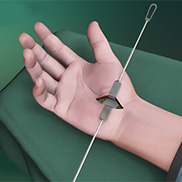
What is Carpal Tunnel Syndrome?
Carpal tunnel syndrome is a common, painful, progressive condition that is caused by the compression of the median nerve at the wrist area.
The common symptoms of carpal tunnel syndrome include numbness and tingling sensation in all the fingers except the little finger, pain and burning sensation in your hand and wrist that may radiate up the arm and elbow, and weakness in hand with diminished grip strength.
Carpal Tunnel Release Surgery
If conservative treatment options fail to resolve the condition your surgeon may recommend a surgical procedure.
Carpal tunnel syndrome can be treated with carpal tunnel release surgery. Traditional surgery involves an incision of up to 2 inches in the palm and wrist area, whereas endoscopic surgery involves one or two half-an-inch incisions and the use of an endoscope. During the surgery, the transverse carpal ligament will be dissected to release the pressure on the median nerve and enlarge the carpal tunnel. Your surgeon will decide which options are best for you based on your general and medical conditions.
Postoperative Care for Carpal Tunnel Release Surgery
Your surgeon may suggest you practice certain postoperative procedures for better recovery and to avoid further complications.
- Elevate your hand above heart level to reduce swelling.
- Wear a splint.
- Apply ice packs to the surgical area to reduce swelling.
- Keep the surgical incision clean and dry. Cover the area with plastic wrap when bathing or showering.
- Physical therapy may be ordered to restore wrist strength.
- Eating a healthy diet and not smoking will promote healing.
Risks and Complications of Carpal Tunnel Release Surgery
Most often, you will not suffer any complications following carpal tunnel release surgery. However, sometime you may suffer from pain, infections, scarring, and nerve damage causing weakness, paralysis, or loss of sensation and stiffness in the hand and wrist area.








